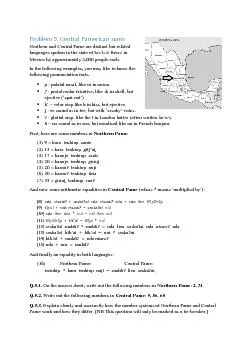/


Problem 9 Northern and Central Pame are distinct but related languages spoken in the state of San Luis Potos ID: 846984
Download Pdf The PPT/PDF document "Central Pamerican sums" is the property of its rightful owner. Permission is granted to download and print the materials on this web site for personal, non-commercial use only, and to display it on your personal computer provided you do not modify the materials and that you retain all copyright notices contained in the materials. By downloading content from our website, you accept the terms of this agreement.
1 Problem 9 . Central Pamerican sums
Problem 9 . Central Pamerican sums Northern and Central Pame are distinct but related languages spoken in the state of San Luis Potosí in Mexico by approximately 5 ,000 people each . In the following examples, you may like to know th e following pronunciation facts. ï· É² - palatal nasal, like ni in onion . ï· Ê â - postalveolar fricative, like sh in shell , but ejective (âspMt outâ) ï· kâ â velar s top like k in kiss , but ejective . ï· á¸ - ee sound as in fee , Nut RitO âcreMkyâ Qoice. ï· Ê - glottal stop, like the t in London butter (often written Nuâer ). ï· Å© â oo sound as in zoo , but nasalised like on in French bonjour . First, here are some numbers in Northern Pame : (1) 9 = kara tenhi u ɲ sant e (2) 13 = kara tenhi u ɲ git Ê â a á¸
2 (3) 17 = kanuje tenhi u ɲ sant
(3) 17 = kanuje tenhi u ɲ sante (4) 20 = kanuje tenhi u ɲ giriu Ḡ(5) 26 = karnu Ê tenhi u ɲ nuji (6) 30 = karnu Ê tenhi u ɲ tiria (7) 35 = giriu Ḡtenhi u ɲ rnu Ê And now some arithmetic equalities in Central Pame (ROere * meMns âmultiplied Nyâ): (8) nda ntsaw Ê + seska Ê ai nda ntsaw Ê nda = nda lien tili ɲ Å© h Å© ɲ (9) ki ɲ ui + nda ntsaw Ê = seska Ê ai nui (10) nda lien nda * nui = nui lien nui (11) tili ɲ Å© h Å© ɲ + kikâai = tilija * nui (12) seska Ê Mi rMnOÅ© Ê * rMnOÅ© Ê = nda lien seska Ê ai nda ntsaw Ê nda (13) seska Ê Mi kikâMi + kikâMi = nui * seska Ê ai (14) kikâMi + rMnOÅ© Ê = nda ntsaw Ê (15) nda + nui = rMnOÅ© Ê And finally an equality
3 in both languages: (16) Northern
in both languages: (16) Northern Pame : Central Pame : teriuhi ɲ * kara tenhi u ɲ nuji = rMnOÅ© Ê lien seska Ê ai, Q . 9.1. On the answer sheet, write out the following numbers in Northern Pame : 2, 31 . Q . 9.2. Write out the following numbers in Central Pame : 9, 56, 60 . Q.9.3. Explain clearly and succinctly how the number systems of Northern Pame and Central Pame work and how they differ. [NB This question will only be marked as a tie - breaker.] Answer sheet 9.1. Northern Pame 2 : 31: 9.2. Central Pame 9: 56: 60: Q.9.3. Explanation Solution and marking . Scoring : max 18 ï· Q.9.1 ,2 . 1 for each correct Pame word (max 13) o Ignore spelling errors (one letter wrong per word) o Require correct position, but only relative to preceding correct words. ï§ e.g. for 56 = lie
4 n nui seska Ê ai tilija , accept a
n nui seska Ê ai tilija , accept all words except nui ï§ for 56 = lien nda ntsaw Ê nda , accept lien ï· Q.9.3. DONâT MARK THIS QUESTION! 9.1. Northern Pame 2 : nuji 31: karnu Ê tenhi u ɲ teriuhi ɲ 9.2. Central Pame 9: nda ntsaw Ê nda 56: nui lien seska Ê ai tilija 60: rMnOÅ© Ê lie n Commentary Northern Pame : ï· base: tenhi u ɲ = 8; ï· order : multiplier _ base _ addend , i.e . the numbers have the following form: α tenhi u ɲ β = 8* α + β , ROere 1 ⤠α , β ⤠7 ; ï· numbers between 1 and 3 have two different names which are used as multipliers and addends, respectively. 1 2 3 4 5 6 7 α kara kanuje karnu Ê giriu Ḡβ sant e nuji rnu Ê giriu Ḡgit Ê â a Ḡtiria teriuh
5 i ɲ Your name:
i ɲ Your name: The UK Linguistics Olympiad 201 8 Central Pame : Since the two languages are cognate, it can be expected that at least some words with identical meanings are going to turn out to be more or less similar. 1 nda 5 kikâMi 9 nda ntsaw Ê nda 2 nui 6 tilija 10 seska Ê ai 3 rMnOÅ© Ê 7 tili ɲ Å© h Å© ɲ 20 nda lien 4 ki ɲ ui 8 nda ntsaw Ê Î² *20 β lien ï· base: 20 , subbase 10 ( seska Ê ai ) ; ï· order : multiplier _ base _ addend , i.e . the numbers have the following form: seska Ê ai β = 10 + β, β ⥠1; α lien β = α*20 + β, α ⥠1, β ⥠1.